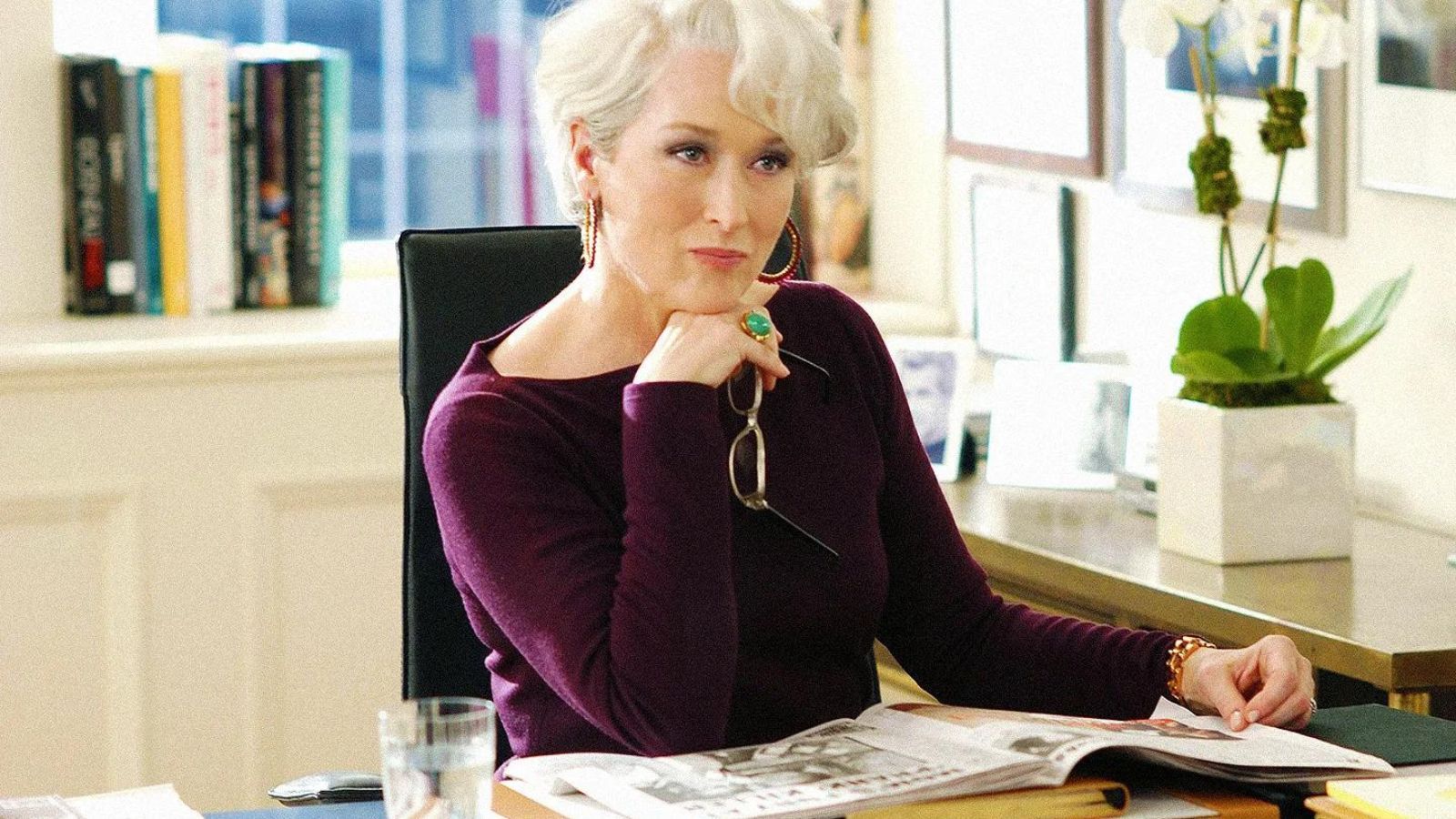
Miranda Priestly's Leadership Style: Management Lessons from The Devil Wears Prada
Her voice, her stature, her eye roll… These are the three things we all remember from Miranda Priestly's character in the popular rom-com The Devil Wears Prada.
On the occasion of the movie's long-awaited sequel (can't wait!), we revisited Meryl Streep's exceptional performance to remember how harsh Miranda was on Andy and Emily and to explore why her management style has been discussed ever since. But beneath the designer outfits and withering remarks lies a leadership approach that, while brutal, offers some surprising takeaways for aspiring managers and leaders in the workplace.
What Is Miranda Priestly's Management Style?
Miranda Priestly's management style is autocratic, results-driven, and built on fear and intimidation. As the demanding editor-in-chief of Runway magazine, she demonstrates exceptional strategic thinking, decisiveness, and an uncompromising pursuit of excellence. However, her leadership approach comes with significant flaws: she rules through fear, sets unrealistic expectations, and shows complete disregard for employee well-being.
While her character serves as a cautionary tale about toxic leadership, there are surprisingly valuable lessons buried beneath her cold exterior—if you know what to keep and what to toss.
We gathered all the valuable information the movie provided and narrowed it down to the things we like about Miranda and the things we don't. So, if you are a manager or your goal is to be in a leadership position, then maybe Miranda Priestly's principles and methods could motivate you to identify the kind of leadership you want to follow—and what you probably don't want to do to make your team stand out.
What We Can Learn from Miranda Priestly's Leadership Style
Despite her harsh methods, Miranda Priestly demonstrates several leadership qualities that drive results. Let's explore the positive aspects of her management approach that can inspire better leadership.
1. Discipline and Unwavering Focus
Miranda is a highly disciplined person. She wakes up early and follows a rigorous schedule. She doesn't get sidetracked by distractions and demands total dedication from her team.

Miranda's presence instantly commands discipline, which is best demonstrated during the scene where Andy laughs during a run-through meeting with the team, calling fashion 'this stuff.' Miranda swiftly turns to Andrea, 'teaching her a lesson' about how the work at Runway has already directly affected her fashion sense despite Andrea's disinterest. She could undoubtedly have avoided public reprimand, but Miranda needed Andrea to take Runway's mission and core values seriously. This eventually motivated Andrea to start exploring fashion trends and revamp her wardrobe.
Discipline is necessary in the work environment to help a team stay focused on an organization's core mission and goals; otherwise, the potential for wasted efforts is more likely.
2. Uncompromising Standards and Pursuit of Excellence
Miranda demands excellence. She has an unwavering vision for Runway and expects her team to execute it flawlessly.
Do you remember the scene where Nigel tells Andy that James Holt is changing his entire collection because she didn't like one dress? Or when she pulled the autumn jackets, which cost the magazine about $300,000? Miranda always wants the best, no matter the cost, just to ensure she has the best outcome for the magazine.
This relentless pursuit of quality can be inspiring, pushing employees to excel and produce their best work.
3. Decisiveness and Quick Judgment
Miranda doesn't waffle. She makes quick decisions and expects them to be followed. She may change her mind, but always with a reason, and she has a Plan B for everything.
She doesn't waste time in making a decision, and she goes for it fast. She also trusts her gut and fashion sense, making it easier to make decisions that are beneficial for the magazine.
This decisiveness can be crucial in fast-paced environments where delays can be costly.
4. Strategic Vision and Big-Picture Thinking
Miranda sees the bigger picture. She understands the fashion industry's intricate web of trends, designers, and advertisers, and the dynamics around the people.
Miranda's strategic thinking is evident during their trip to Paris when a crisis arises with the upcoming Paris Fashion Week. She quickly makes adjustments, sending Andy to Paris despite her initial resistance. This decision ensures Runway magazine remains in the loop regarding crucial fashion events and protects the organization's interests.
This kind of strategic thinking allows leaders to anticipate challenges and make informed choices.
The Problems with Miranda Priestly's Management Approach
While Miranda demonstrates impressive leadership qualities, her toxic methods create a hostile work environment that ultimately undermines long-term success. Here's what modern managers should absolutely avoid.
1. Leadership Through Fear and Intimidation
Miranda's go-to management style is fear and intimidation. She humiliates and belittles her assistants, Andy and Emily, creating a toxic work environment. She doesn't accept any other opinion and blackmails people to do what she wants—what she did to Andy for the Paris trip in order to make her go, mentioning that if she didn't go, then 'she didn't take seriously her job in Runway… or another magazine.'
Her strict and rigid approach destroys morale, stifles creativity, and leads to high turnover.
2. Unrealistic and Unreasonable Expectations
Miranda's demands often go beyond reasonable. She expects her assistants to be available 24/7, handle her personal errands, and anticipate her every need.
In the scene where she wants the new, unpublished manuscript of Harry Potter for the girls, she just mentions to Andrea, 'And if you don't have that Harry Potter book by then, don't even bother coming back.' Also, you definitely remember how she treated Andy when she sacrificed her evening with her dad to get her back home from Miami, but she failed.
When managers have unrealistic expectations from their employees, it sets them up for failure and breeds resentment, making them feel useless and inadequate, hence affecting their performance.
3. Complete Disregard for Employee Well-Being
Miranda has no interest in her employees' well-being. She views them as tools, expendable in her pursuit of success. She doesn't care that Emily was hit by a car; she doesn't care whether their employees have a personal life and just wants them to do their job.

In a healthy work environment, leaders and managers know that work never stops and treat their employees as human beings. They also accept that employees have a life outside their jobs and care about their overall well-being and mental health. Any lack of empathy on the manager's part creates a cold, impersonal workplace that demotivates even the most dedicated employees.
Frequently Asked Questions About Miranda Priestly's Leadership
Is Miranda Priestly's management style effective?
Yes and no. Miranda's strategic thinking, decisiveness, and high standards drive results and maintain Runway's position as a leading fashion magazine. However, her fear-based tactics, lack of empathy, and unrealistic expectations create a toxic work environment that leads to high turnover and employee burnout. While she achieves short-term success, her approach is unsustainable for long-term organizational health.
What leadership style does Miranda Priestly use?
Miranda Priestly uses an autocratic, results-driven leadership style characterized by fear and intimidation. She makes all decisions unilaterally, demands absolute obedience, and prioritizes outcomes over employee well-being. While she demonstrates strategic thinking and decisiveness, her management approach creates a hierarchical, controlled environment where employees have little autonomy or voice.
What can leaders learn from Miranda Priestly?
Leaders can learn from Miranda's uncompromising standards, quick decision-making, strategic vision, and unwavering focus on excellence. However, these traits should be balanced with empathy, reasonable expectations, and respect for work-life boundaries. The key is to adopt her results-oriented approach while ditching the soul-crushing tactics that damage team morale and well-being.
Why do people still analyze Miranda Priestly's leadership?
Miranda Priestly remains a compelling case study because she embodies the tension between achieving excellence and maintaining humanity in leadership. Her character forces us to examine what we're willing to sacrifice for success and challenges us to find better ways to lead. She represents both what to emulate (strategic thinking, high standards) and what to avoid (fear-based management, lack of empathy) in modern leadership.
Key Takeaways: Applying Miranda Priestly's Best Traits Without the Toxicity
Overall, Miranda Priestly may be a tyrant, but there are a few nuggets of valuable leadership buried beneath her designer facade.
What to adopt from Miranda Priestly:
• Uncompromising standards and pursuit of excellence
• Decisiveness and confidence in decision-making
• Strategic thinking and big-picture vision
• Discipline and unwavering focus on organizational goals
What to avoid from Miranda Priestly:
• Leadership through fear and intimidation
• Unrealistic expectations and 24/7 availability demands
• Complete disregard for employee well-being and work-life balance
• Humiliation and public belittlement of team members
The key takeaway? Take Miranda's results-oriented approach, but ditch the soul-crushing tactics.
Her strategic vision, decisiveness, and high standards can be assets in the right hands when combined with empathy, reasonable expectations, and genuine care for your team's well-being. Modern leaders can learn from Miranda's strengths while creating a healthier, more sustainable work environment that drives results without destroying morale.
Your team—and your sanity—will thank you for it!






